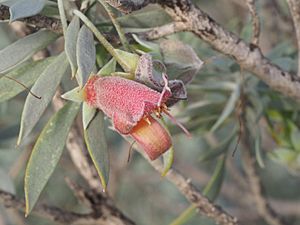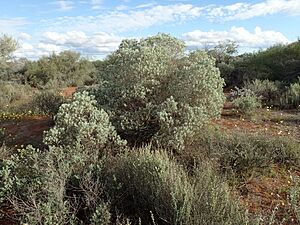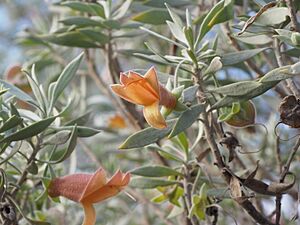Eremophila pterocarpa subsp. pterocarpa facts for kids
Quick facts for kids Silver poverty bush |
|
|---|---|
 |
|
| E. pterocarpa subsp. pterocarpa leaves and flowers | |
| Scientific classification |
|
| Kingdom: | Plantae |
| Clade: | Tracheophytes |
| Clade: | Angiosperms |
| Clade: | Eudicots |
| Clade: | Asterids |
| Order: | Lamiales |
| Family: | Scrophulariaceae |
| Genus: | Eremophila |
| Species: | |
| Subspecies: |
E. p. subsp. pterocarpa
|
| Trinomial name | |
| Eremophila pterocarpa subsp. pterocarpa |
|
The Silver Poverty Bush (Eremophila pterocarpa subsp. pterocarpa) is a special plant. It belongs to the figwort family, also known as Scrophulariaceae. This plant is found only in Western Australia, meaning it is endemic there.
It is a common and widespread plant. You can spot it as a large shrub or a small tree. It has unique grey leaves and sepals, which are the leaf-like parts that protect the flower bud. Its flowers can be orange, pink, or yellow.
Contents
What Does It Look Like?
The Silver Poverty Bush grows as a shrub or a small tree. It can reach a height of about 0.8 to 5 meters (around 2.6 to 16 feet). Its branches have clear ribs, like small ridges.
Leaves and Stems
The leaves of this plant are long and narrow. They are usually 20 to 40 millimeters (about 0.8 to 1.6 inches) long. They are also 2 to 5.6 millimeters (about 0.08 to 0.22 inches) wide. Each leaf has a pointed tip. Both the leaves and stems feel soft and dusty. This is because they are covered with short, matted hairs. Many leaves have a twisted base. This makes them face sideways, or horizontally.
Flowers and Fruits
The flowers of the Silver Poverty Bush are very pretty. They can be red, yellow, or orange. You will find them growing one by one where the leaves meet the stem. Each flower sits on a stalk that is 10 to 16 millimeters (about 0.4 to 0.6 inches) long.
The flower has five sepals. These are small, leaf-like parts that protect the flower bud. They are narrow and shaped like an egg or a triangle. The petals are the colorful parts of the flower. They are 14 to 24 millimeters (about 0.55 to 0.94 inches) long. The petals join together to form a tube. At the end of the tube, there are five lobes, or sections. Like the leaves, the sepals and petals also have a dusty covering of fine hairs.
The Silver Poverty Bush usually flowers between June and September. After flowering, it produces fruits. These fruits are flat and dry. They have papery wings, which help them spread.

How It Was Named
This plant was first officially described in 1904. A scientist named William Vincent Fitzgerald wrote about it. His description was published in a journal by the Royal Society of Western Australia.
Later, another scientist named Robert Chinnock studied the Eremophila group of plants. He found that there were two types, or subspecies, of E. pterocarpa. One was E. pterocarpa subsp. acicularis. The other was the original type, E. pterocarpa subsp. pterocarpa.
Where It Lives
The Silver Poverty Bush (subspecies pterocarpa) grows in a specific area of Western Australia. You can find it between the Cape Range, Shark Bay, and Meekatharra regions.
It prefers to grow in certain types of soil. These include sandy clay or soils that come from limestone. You can often see it in flat areas or places with salty soil.
Is It Protected?
The Government of Western Australia's Department of Parks and Wildlife keeps track of plants. They have listed the Silver Poverty Bush (subspecies pterocarpa) as "not threatened." This means it is not currently in danger of disappearing.


